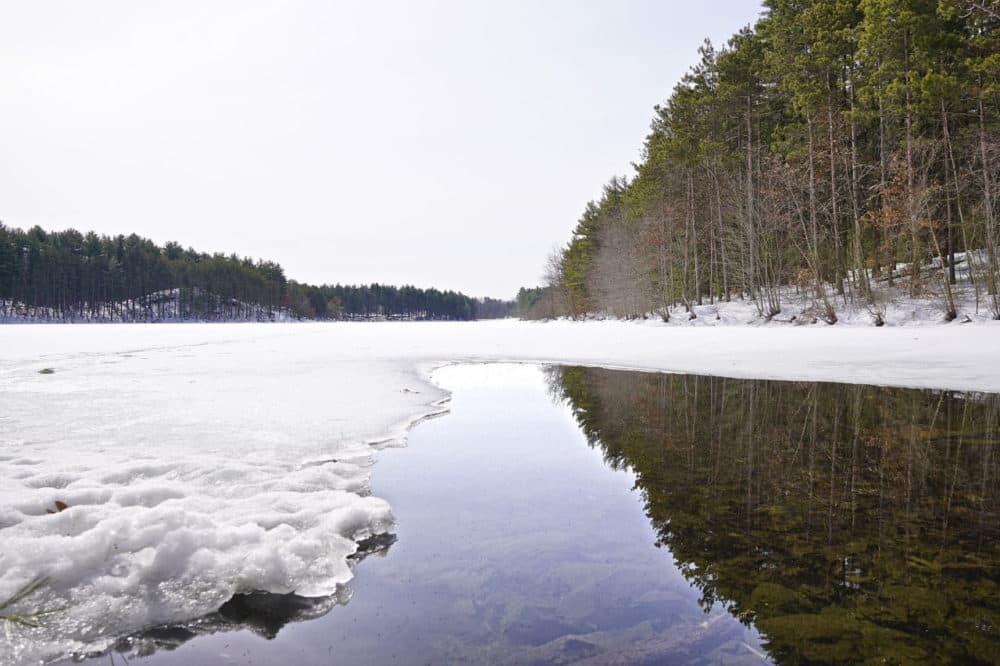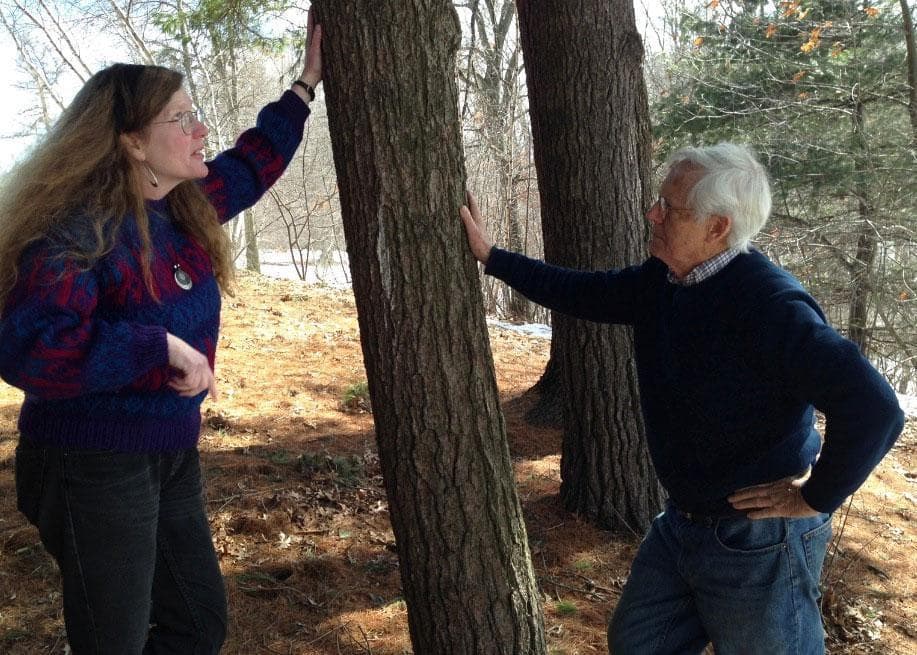Advertisement
Lilac, Hemlock, Maple: How Climate Change Is Transforming New England Plant Life
Resume
These waning March days, the trails are still coated in ice and snow at the Middlesex Fells, a sprawling reservation of woods and water just north of Boston. Around Spot Pond, the branches are bare on the beeches and alders, the dark green of pines the only vivid color in the gray-brown palette of early spring.
It's a scene that has changed little in more than 100 years — but may change dramatically in the coming half-century.
If global climate change continues unabated, in 50 years "One could posit that Massachusetts would look an awful lot like Georgia or even northern Florida," says Elizabeth Farnsworth, senior research ecologist at the New England Wild Flower Society.
Which would mean, for a spot like Spot Pond, that "If we were standing out here in mid-late March, we might actually expect to see a lot of these species flowering already. We’re already seeing changes in the flowering times of a number of species. They’re flowering two weeks earlier in the year than they used to 50 years ago."
Farnsworth is the author of "State of the Plants," a new report that the New England Wild Flower Society calls the most thorough ever compiled on the status of the region's plant life.
It finds that New England is home to nearly 600 rare or endangered native plant species, about a fifth of all its species. And among the threats that New England plants face is climate change: If current trends continue, the report notes, in 50 years, Vermont will have the climate of current-day North Carolina.
How would that alter the New England plant landscape? In myriad ways, but consider just the colorful sugar maples that are the region's iconic trees. Farnsworth says they could be forced northward, because they can’t tolerate higher temperatures.
"In a higher emission scenario, which is also possible if greenhouse gas emissions just continue to rise, maples could be restricted to northern Maine," she says.
Already, climate change has begun to leave its mark on the region's flora.

Bryan Hamlin, board chair of the The Friends of the Fells, knows the botany of these woods intimately, and says he’s witnessed two big shifts in recent years.
"Some species that don’t like it too warm have moved north. Other species are coming up from Connecticut. So that's one thing we're noticing," he says. "The other thing that comes, because it’s climate change, not just warming: As we have seen in the last month, precipitation has increased, something like 10 percent in the last 30 years." And meanwhile, the forest has matured. "So any plants that like it dark and damp, they have flourished."
Hamlin has seen subtler changes as well, with connections to climate change that are likely but not as clear: "We’re losing orchids. Just in the 12 years I’ve been walking these woods, I’ve seen the orchids really retreat. We’ve lost two or three species just in the last few years."
Also, the hemlocks of the Fells are under attack by woolly adelgids, pests that the warmer climate has prompted to move north. "The hemlocks are dying here in the Fells," Hamlin says.
And concern is mounting about another pest, the emerald ash borer, that attacks ash trees and has recently appeared in Massachusetts and New Hampshire, Farnsworth says.
Climate effects can even be seen in the earlier blooming times and faster withering of the region's fragrant and much-beloved lilacs, Farnsworth notes. And old photographs from 100 years ago show that deciduous trees had not yet unfurled their leaves by Memorial Day, Hamlin says, while trees today "leaf-out" by earlier in May.
The effects 'may be small at an individual level,' Farnsworth says, 'but if 3 million people do it, it has a huge collective impact.'
The long-term predictions may sound dire, but Farnsworth emphasizes that the new "State of the Plants" report is not a doom-and-gloom warning of impending environmental disaster in New England.
"Plants are remarkably resilient creatures," she says. "They have been around for many, many millions of years longer than we have, and they will win out. Taking a long view, there will be certain species that thrive and perhaps others that fall by the wayside, but plants are tremendously resilient, they're adaptable, they can evolve in response to climate change and other stressors."
And, Farnsworth says, the risks that climate change poses to the region’s plants are not irreversible — if people take action.
"There are things that we can do at an individual level which are really pretty simple," she says. Along with familiar methods for reducing carbon footprints, such as installing solar panels, she suggests that New England residents plant more native plants.
And if you live in an urban area, she says, "Green up your roof! And use some native plants — like goldenrod and some of our native roses." Other native plants include violets, trilliums and a wide range of flowers, herbs, shrubs and small trees.
She also suggests cutting back on herbicides and pesticides, and just getting out more to appreciate and learn about nature. People tend to have "plant blindness," she says, their attention naturally attracted by animal movement rather than stationary plants.
The effects "may be small at an individual level," she says, "but if 3 million people do it, it has a huge collective impact."
Already, the "State of the Plants" report says, about 12 percent of New England land is under some sort of conservation protection, making this region a model for the nation.
Farnsworth says she hopes the new report will lead to more of a national focus on plant life, "because we're not going to be able to save the birds or save the pollinators or save the mammals if we don't pay attention to their habitats," and "plants are the habitats."
A summary of the report's main findings from the New England Wild Flower Society:
- Plants are in trouble worldwide and in New England, where 22 percent of native plant species — 593 species — are listed as rare or possibly extinct, and 31 percent of plants are non-native.
- After a century of reforestation, New England's forest cover is declining, along with plant diversity.
- Climate change is already affecting New England plant communities and will accelerate if current trends continue. Forest, alpine, coastal and estuarine species are most at risk. If current trends continue, Vermont will have the climate of Connecticut by 2039 and of North Carolina by 2070.
- Multiple threats, ranging from land development to widespread pesticide use to invasive species, together undermine the resilience of our native plant communities.
- Insect-pollinated plants — the majority of native plants - are in particular trouble and are declining along with insects that pollinate and rely on them.
Correction: A previous version of this post incorrectly described the New England states where the emerald ash borer has been found. They are Massachusetts and New Hampshire.
This segment aired on March 26, 2015.
